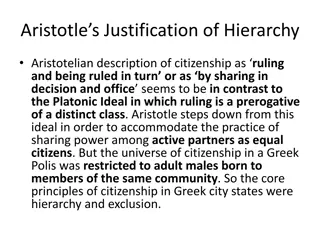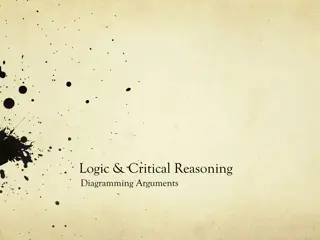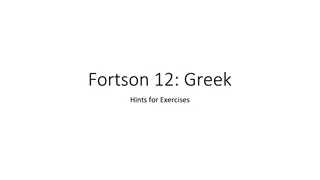Re-Framing the Argument: Understanding Greek Roots and Aristotle's Theory
Delve into the evolution of argument theory from the Greek Sophists to Aristotle's three major branches - Syllogistic Logic, Dialectic, and Rhetoric. Explore the historical context, theoretical underpinnings, and contemporary teaching methods related to argumentation skills in liberal arts education.
Download Presentation

Please find below an Image/Link to download the presentation.
The content on the website is provided AS IS for your information and personal use only. It may not be sold, licensed, or shared on other websites without obtaining consent from the author.If you encounter any issues during the download, it is possible that the publisher has removed the file from their server.
You are allowed to download the files provided on this website for personal or commercial use, subject to the condition that they are used lawfully. All files are the property of their respective owners.
The content on the website is provided AS IS for your information and personal use only. It may not be sold, licensed, or shared on other websites without obtaining consent from the author.
E N D
Presentation Transcript
FACTORS INFLUENCING TRAINING POTENTIAL Somatotype Gender Men are potentially stronger than women Women are potentially more flexible than men Current fitness level Lifestyle Diet Smoking Occupation Current activity levels Pregnancy General health Age
PRINCIPLES OF TRAINING FITT Frequency How often-increases as fitness progresses Intensity How hard-increased by Increasing or decreasing speed, depending upon exercise Adding impact Larger movements, higher arms Use of longer levers Working against gravity Increasing resistance Time How long Type The exercise you do
PRINCIPLES OF TRAINING Specificity Adaptation Overload Reversibility Progression Overtraining Periodization
PRINCIPLES OF TRAINING Specificity Identifying specific goals for the conditioning program Closer the training is to desired outcome, the better the outcome will be Ex: runners run, cyclists cycle, swimmers swim, etc.
PRINCIPLES OF TRAINING Adaptation Body adapts to regular training with: Improved heart function and circulation, Improved respiratory function, Improved muscular strength and endurance Improved flexibility
PRINCIPLES OF TRAINING Overload Perform at a level above normal by increasing: Frequency Duration Intensity Not overloading may be a reason for not seeing results even though exercising regularly SAID Principal Specific Adaptations to Imposed Demands
PRINCIPLES OF TRAINING Reversibility Fitness decreases if training stops Strength gains are generally lost more quickly than flexibility gains These reverse changes may begin in as little as 48 hours up to two weeks depending on training level
PRINCIPLES OF TRAINING Progression Necessary for fitness gains As the muscles become stronger/more efficient, they need more resistance/duration Apply the principles of FITT Frequency Intensity Time Type
PRINCIPLES OF TRAINING Lever Length and Gravity Gravity Can provide built in resistance Lever length Long levers Arms and legs fully extended Fulcrum is the shoulders or hips Combine short and long levers for safer workout
PRINCIPLES OF TRAINING OVERTRAINING SYNDROME Occurs typically in competitive or obsessive athletes An overload of the body s physiological capabilities without a proper recovery time Various signs & symptoms subjective! Decline in physical performance despite continued training Change in appetite Weight loss Sleep disturbances Repeated colds or sore throats Irritability, restlessness, excitability &/or anxiousness Loss of motivation Lack of mental concentration & focus Lack of enjoyment *Associated with depression!
EXERCISE PROGRAMS MUST BE DESIGNED TO INCLUDE BOTH REST AND DAYS OF VARIED LEVEL OF TRAINING INTENSITY!
PRINCIPLES OF TRAINING Periodization Used to prevent/alleviate issues associated with overtraining Alternate easy, moderate, & hard periods of training For example: Two days of hard intensity should be followed by two days of easy intensity or rest. A week or two of hard training should be followed up with a week or two of easy training A new training program should begin with at least 5 to 10 easy training sessions before making a progression!























